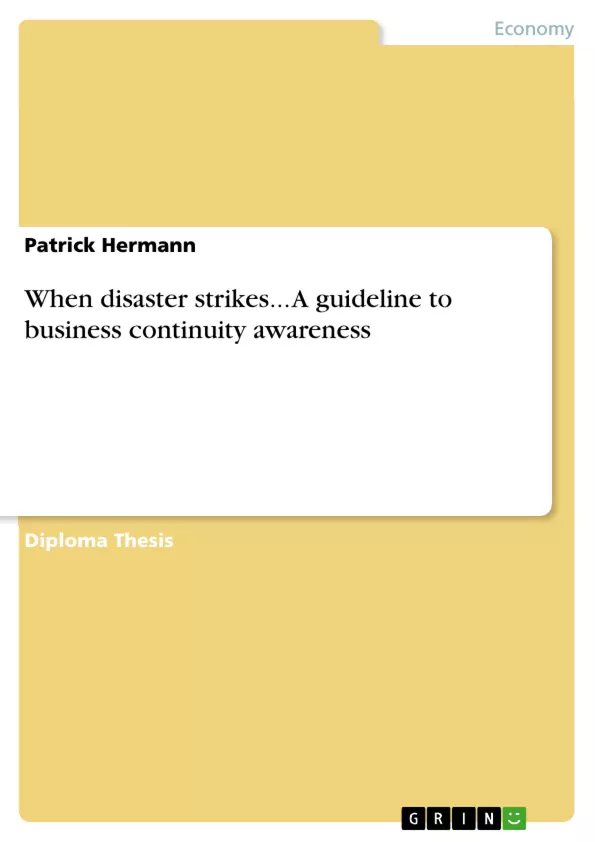”When there is a crisis, the crisis has to be managed”, was once said by Gerhard Schröder, the former German Chancellor. In actual disaster situations it is not as easy to handle the crisis and just “manage” it, you better be prepared.
When disaster strikes… these incidents cannot usually be handled with the organizational structures and resources provided for “normal everyday business” and therefore require a business continuity plan.
As we have experienced an increasing number of disaster events over the recent years, big and dramatic events like – the World Trade Center terrorist attack of 9/11, the Madrid and London train bombings, earthquakes in Pakistan, hurricanes in North America or the Southeast Asia tsunami, which were highly recognized in the media all over the world. But at the same time there have been also large number of disasters at a less recognized level, like fires, flooding, building crush down, and so forth. All these events have one thing in common: They can put a company out of business. To prevent that we are not prepared to respond these disaster events, we need to have a plan!
But planning for an event can only be the first step, next we need to implement these plans in our organization and make communicate it, to ensure that every employee knows what to do and how to react in a disaster event. Many organizations fail to actually implement a BCP program because of the perception that it is a process that is too costly, time-consuming, and requires a large amount of resources. Therefore the management must be assured that by investing in BCP, the organization’s life gets protected and that it makes good business sense.
Inhaltsverzeichnis (Table of Contents)
- Introduction
- Motivation
- Context and assignment of the thesis
- Goals of the thesis
- Methodology
- Singapore's cultural dimensions
- Singapore State
- Hofstede's Dimensions of Culture
- Power Distance
- Uncertainty Avoidance (UA)
- Singapore's SARS crisis
- Sample AG
- Organization of Sample Pte Ltd, Singapore
- The Corporate Information Office
- BCP of SAMPLE Pte Ltd Singapore
- Basics - Business Continuity Planning
- BCP as Project
- Definition of Business Continuity Planning
- Dimensions of Business Continuity Planning
- The BCP planning method
- Business Continuity Institute
- Disaster Recovery Institute International
- The Phases of the BCP development process
- Business Impact Analysis
- Definition of Business Impact Analysis
- Goals and contents of a BIA
- Methods for collecting Data
- Key Performance Indicator Review
- Process Flows
- Questionnaires
- Disaster Recovery Planning
- Testing of BCPs
- Walk-through
- Simulation
- Problem analysis
- Analysis of the Business Continuity Plans at SAMPLE PL
- Requirements of the business continuity plans at SAMPLE PL
- GAP-Analysis
- Summary
- Proposal of solution
- Parameters for embedding of BCP
- Objectives for a solution concept
- Change Management
- Strategy for implementation
- Simulation Training
- Awareness Program
- Developing a BCP culture
- Summary
- Implementation of solution
- BCP Communication
- Leaflets
- Crisis Information Number
- Summary of Business Continuity Plans
- BCP Intranet site
- BCP podcast
- BCP Web site
- Crisis Reporting Number
- BCP Crisis Conference number
- BCP Process
Zielsetzung und Themenschwerpunkte (Objectives and Key Themes)
This diploma thesis aims to explore the concept of business continuity planning (BCP) and its application in the context of Singapore. The specific focus is on the development and implementation of a BCP framework for a hypothetical company, Sample Pte Ltd, in Singapore. The thesis draws upon the country's unique cultural dimensions, particularly Hofstede's dimensions of culture, to understand the potential challenges and opportunities for BCP implementation.
- Business Continuity Planning (BCP) and its application in Singapore
- Impact of cultural dimensions on BCP implementation
- Developing a BCP framework for a hypothetical company in Singapore
- Importance of communication and awareness in BCP
- Lessons learned from Singapore's SARS crisis
Zusammenfassung der Kapitel (Chapter Summaries)
The thesis begins by introducing the motivation and context behind the study, outlining the goals and methodology. It then explores Singapore's cultural dimensions, focusing on Hofstede's dimensions of culture, particularly Power Distance and Uncertainty Avoidance. The thesis also examines Singapore's experience with the SARS crisis as a relevant case study for understanding disaster preparedness.
Following the introduction, the thesis delves into the basics of BCP, defining the concept, outlining the various dimensions, and discussing the key phases of the BCP development process. It further explores the importance of Business Impact Analysis (BIA) as a crucial step in the planning process.
Chapter 4 then analyzes the existing BCP at SAMPLE PL, identifying key requirements and conducting a gap analysis to determine areas for improvement. The thesis then proceeds to outline a proposed solution, setting out the objectives, strategy, and implementation plan for a more comprehensive BCP framework.
The final chapters focus on the practical aspects of BCP implementation, including communication strategies, process development, and the creation of awareness programs. The thesis concludes with a summary of findings, reflections on achieved goals, and recommendations for future work.
Schlüsselwörter (Keywords)
This thesis explores key concepts like Business Continuity Planning (BCP), Disaster Recovery Planning (DRP), Business Impact Analysis (BIA), cultural dimensions, Hofstede's dimensions of culture, Power Distance, Uncertainty Avoidance, and the impact of the SARS crisis on BCP implementation. The thesis also examines important practical aspects such as change management, communication, and awareness program development, all within the specific context of Singapore.
- Citar trabajo
- Diplom Betriebswirt Patrick Hermann (Autor), 2006, When disaster strikes... A guideline to business continuity awareness, Múnich, GRIN Verlag, https://www.grin.com/document/87136



